Emergency Eye Washes & Showers
For many employers, selecting and maintaining safety equipment for OSHA eye wash station requirements is a small component of their overall safety plan. There are many pre-emergency measures that are necessary to ensure a safe environment for team members, as well as meeting complex OSHA requirements. Emergency response can sometimes be an afterthought, as prevention is perceived as paramount.
However, OSHA eye wash station requirements call out and address emergency eyewash and shower equipment response requirements in 29 CFR 1910.151. Specifically, OSHA states: “Where the eyes or body of any person may be exposed to injurious corrosive materials, suitable facilities for quick drenching or flushing of the eyes and body shall be provided within the work area for immediate emergency use.” i A key emphasis should be placed on the terms “suitable” and “immediate” as those are of vital importance when procuring, planning, and maintaining emergency equipment.
Since 1981, The International Safety Equipment Association (ISEA) has been producing the American National Standard for Emergency Eyewash and Shower Equipment, ANSI Z358.1, to establish uniform minimum performance and use requirements. The Standard is a comprehensive outline that serves as a guideline for companies and safety professionals to provide safe working environments. OSHA eye wash station requirements often refer employers to the ISEA/ANSI standard for deeper definition of “suitable” and “immediate.” By applying a few additional best practices, you can exceed the minimum response requirements and ensure that each site implements and, more importantly, manages appropriate emergency response systems, minimizing related employee injuries, preventing a crisis situation from going from bad to worse.
While the hope may be that you’ll never have to use your emergency equipment, you should maintain the mindset that an emergency could happen at any moment. When a victim needs an eyewash or shower, you and the victim must have confidence that your eye or face wash is working properly to provide the care that is needed.
In a safety industry survey conducted by Haws®, professionals who make product recommendations and/or buying decisions were asked what they considered the most important factors when selecting an eyewash and/or eyewash/ shower combination unit. Not surprisingly, the top two answers were ANSI compliance and victim comfort. Victim comfort is an important consideration that should be factored into creating a complete safety response environment for your employees. By putting yourself in a victim’s shoes when making a purchasing decision you are most likely to purchase equipment that not only meets the ANSI standard, but provides the most critical care during an emergency.
Beyond the purchase of emergency eyewash and/or eyewash/ shower combination units, it is critical to ensure that the equipment is functioning properly and highly visible in case of an emergency. Based on a sample of testing and review by Haws® Services it was found that while all sites believed they were in compliance, 75% of equipment tested was actually non-compliant for both minor and significant violations.
Proper Product Specification & Placement
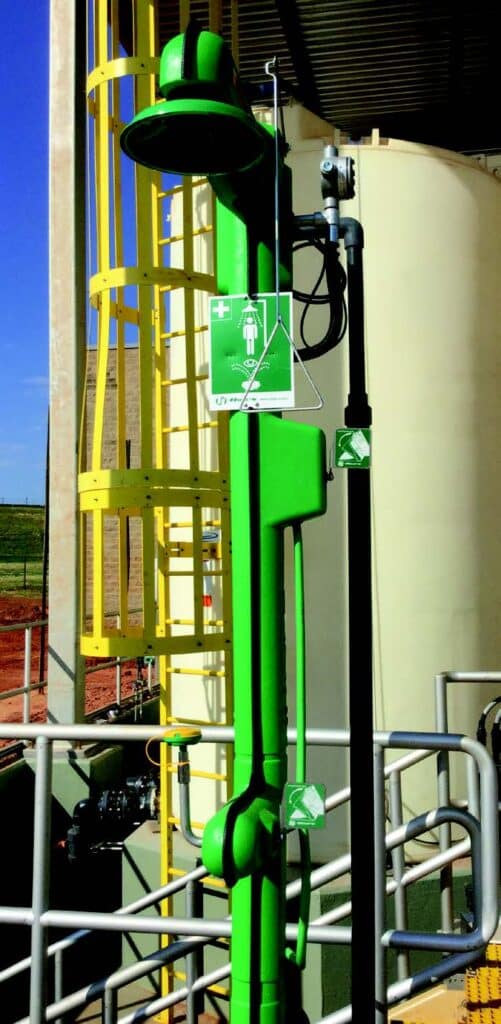 When it comes to emergency response equipment, there is no shortage of available products. With many choices – oftentimes differentiated only by subtle differences – it’s important to critically assess specific risks to determine the most suitable product. For example, in a chemical plant where liquids form the general risk, an eye/face wash would be the most appropriate choice. With recent product advancements such as flow controls and designs inspired by eye irrigation protocols used within the medical community, choosing the most suitable equipment also means selecting from the most current generation of products. Many of these have been designed to meet changes imposed in the Z358.1 Standard revision (2009).
When it comes to emergency response equipment, there is no shortage of available products. With many choices – oftentimes differentiated only by subtle differences – it’s important to critically assess specific risks to determine the most suitable product. For example, in a chemical plant where liquids form the general risk, an eye/face wash would be the most appropriate choice. With recent product advancements such as flow controls and designs inspired by eye irrigation protocols used within the medical community, choosing the most suitable equipment also means selecting from the most current generation of products. Many of these have been designed to meet changes imposed in the Z358.1 Standard revision (2009).
Now that you’ve selected the proper equipment, location should be the next critical consideration. Per ANSI, emergency equipment must be located on the same level and within an unobstructed, 10-second walk from a potential hazard (roughly 55 feet). The number of showers/eyewashes available and their individual locations must be evaluated when determining installation locations.
ASSURE PROPER VISIBILITY
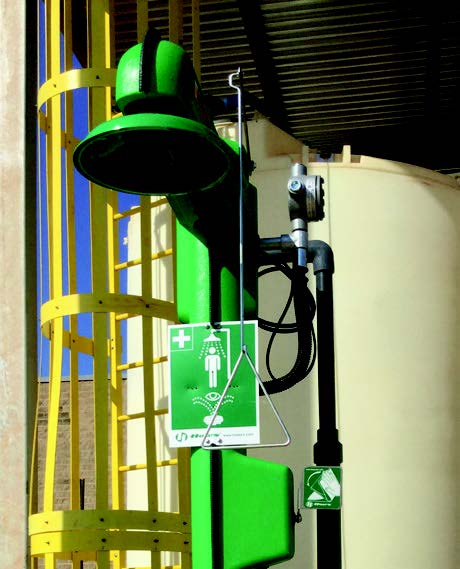 High visibility of safety equipment can be achieved with clear signage, proper lighting and the use of the color known as “safety green.” This color is used industrially to designate both the concept of safety and the physical locations of first aid and emergency response equipment, including drench showers and eyewashes. ANSI Z535.1 takes this one step further by providing a standard for color schemes, sizing, meaning and application for various workplace hazards. The standard is intended to provide uniformity across organizations and industries by helping employees identify the severity of a given hazard in the workplace. Often, an emergency station is not clearly marked, causing the victim to frantically locate an improper form of flushing such as a sink. Consistently using the familiar color for emergency signage can minimize unnecessary confusion in a crisis, especially if the injured party has contaminants in or around their eyes, reducing visibility.
High visibility of safety equipment can be achieved with clear signage, proper lighting and the use of the color known as “safety green.” This color is used industrially to designate both the concept of safety and the physical locations of first aid and emergency response equipment, including drench showers and eyewashes. ANSI Z535.1 takes this one step further by providing a standard for color schemes, sizing, meaning and application for various workplace hazards. The standard is intended to provide uniformity across organizations and industries by helping employees identify the severity of a given hazard in the workplace. Often, an emergency station is not clearly marked, causing the victim to frantically locate an improper form of flushing such as a sink. Consistently using the familiar color for emergency signage can minimize unnecessary confusion in a crisis, especially if the injured party has contaminants in or around their eyes, reducing visibility.
Provide Tepid Water
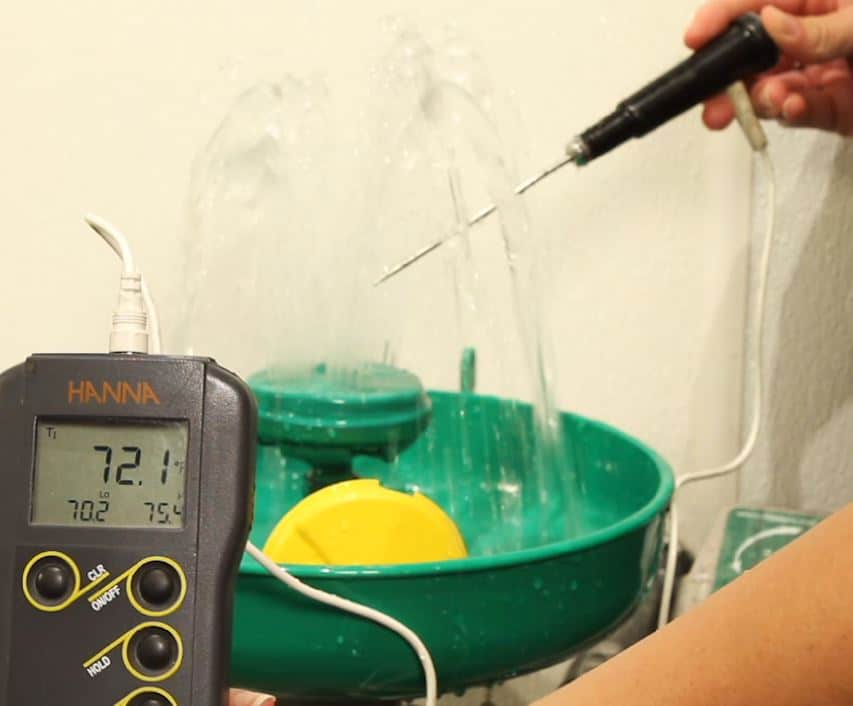 Excessively hot- or cold-water temperatures in safety showers and eyewashes can exacerbate the very injuries the safety equipment is designed to reduce. In the 2009 revision of ANSI Z358.1, the standard outlines suitable water temperatures as tepid, defined as a range between 60˚ and 100˚F (15.5˚ to 37.77˚C). It also specifies a full 15-minute drench or irrigation cycle, a length of time that must be considered with the victim in mind. An uncomfortable victim will be less inclined to abide by the flush requirements, which could worsen an injury. By selecting a suitable mixing valve and defining a tepid water range that is more comfortable to the user, you are not only encouraging the full flush period but also increasing the likelihood that a victim will remove contaminated clothing, which further enhances the wash objective.
Excessively hot- or cold-water temperatures in safety showers and eyewashes can exacerbate the very injuries the safety equipment is designed to reduce. In the 2009 revision of ANSI Z358.1, the standard outlines suitable water temperatures as tepid, defined as a range between 60˚ and 100˚F (15.5˚ to 37.77˚C). It also specifies a full 15-minute drench or irrigation cycle, a length of time that must be considered with the victim in mind. An uncomfortable victim will be less inclined to abide by the flush requirements, which could worsen an injury. By selecting a suitable mixing valve and defining a tepid water range that is more comfortable to the user, you are not only encouraging the full flush period but also increasing the likelihood that a victim will remove contaminated clothing, which further enhances the wash objective.
Selecting a thermostatic mixing valve that offers protection against temperature spikes is an ideal solution to providing reliable temperature controls. A paraffin-base thermal actuation will keep outlet temperature within tight specifications to prevent scalding and hypothermia. In addition, a funnel design in the mixing chamber generates turbulent flow to ensure consistent temperature blending across the entire flow range.
PERFORM CONTINUOUS MAINTENANCE & TESTING
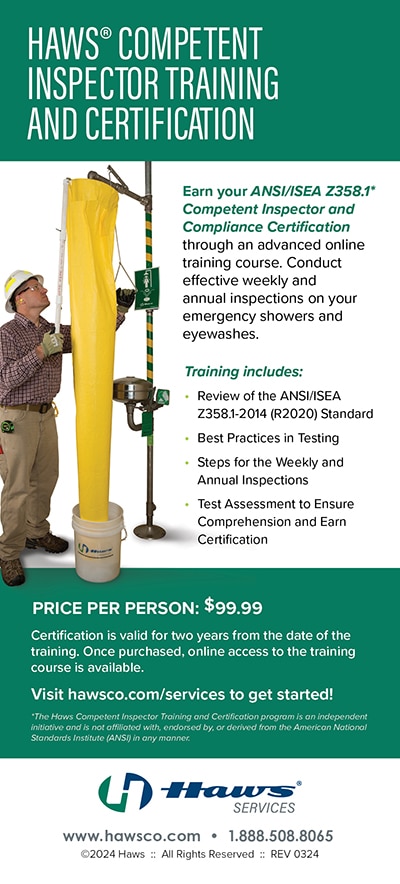 One of the implied responsibilities of specifying and installing emergency equipment is assuring a maintenance process is designed to keep safety showers, eyewashes and associated system components functioning optimally. A common question relates to the appropriate frequency and length of time for unit testing. While a quick, random activation to test the unit might seem sufficient, it is more impactful and valuable to test each unit for the required 15-minute flush every time. The intention behind routine testing is not only to guarantee that each piece of equipment has the proper flushing fluid supply and flow, but also to clear the line of any sediment build-up and to minimize contamination related to inactive water. Testing should replicate a real-life scenario to ensure that each site can be confident in the emergency unit’s ability to reliably perform. In addition, documentation of the routine testing including location, dates and performance provides records to demonstrate your facility’s diligence in protecting and monitoring each unit. These records can be managed in a variety of forms, including inspection tags on the units and safety equipment surveys. The proper coordination of testing alleviates any questions or concerns related to functionality and allows your safety team an instant reference for monitoring all safety equipment performance.
One of the implied responsibilities of specifying and installing emergency equipment is assuring a maintenance process is designed to keep safety showers, eyewashes and associated system components functioning optimally. A common question relates to the appropriate frequency and length of time for unit testing. While a quick, random activation to test the unit might seem sufficient, it is more impactful and valuable to test each unit for the required 15-minute flush every time. The intention behind routine testing is not only to guarantee that each piece of equipment has the proper flushing fluid supply and flow, but also to clear the line of any sediment build-up and to minimize contamination related to inactive water. Testing should replicate a real-life scenario to ensure that each site can be confident in the emergency unit’s ability to reliably perform. In addition, documentation of the routine testing including location, dates and performance provides records to demonstrate your facility’s diligence in protecting and monitoring each unit. These records can be managed in a variety of forms, including inspection tags on the units and safety equipment surveys. The proper coordination of testing alleviates any questions or concerns related to functionality and allows your safety team an instant reference for monitoring all safety equipment performance.
CREATE A ROBUST SAFETY CULTURE
This may be the most important overarching aspect of what we do in the safety industry, yet it is not covered as thoroughly as it should be. The hope is that emergency eyewashes and showers will never have to be used, and it is this mindset that exposes facilities to risks and potential severe fines for non-compliance. It is often that these pieces of equipment are out-of-sight and out of mind, which could pose a fatal threat during a crisis. The key to overcoming this mentality is developing a strong safety culture and understanding the risks of noncompliance. In 2016, OSHA increased its penalties by 80% and that rate continues to increase annually based on the Consumer Price Index yearly percentage increase. Consider the OSHA penalty hike a boon for workplace safety. Studies have shown that workplace injuries are reduced in settings in which health and safety inspections have direct consequences for violations. And while it can seem like the impossible to build a system with the resources to inspect every single workplace for violations, increasing employer awareness about steep financial penalties for non-compliance may well do the trick.
Emergency equipment protocols need to be robust to be effective. Knowledgeable personnel should be responsible for the development and execution of a cohesive safety program necessary to not only meet minimum requirements, but to cultivate a culture of safety for all employees. There are various safety service offerings to help standardize and maintain safety equipment. A subject matter expert can be a helpful resource to alleviate work load and guarantee functionality.
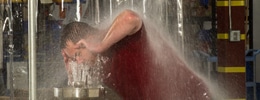
Haws holds itself to the highest standard when it comes to a safety culture with recognition by OSHA and SHARP (Safety & Health Achievement Recognition Program) status. Our safety culture is engrained in all that we do, from providing ANSI Z358.1 compliance resources and education, to the products we develop and recommend, and the service and maintenance we provide post-sale.
HAWS SERVICES is a warranty and service provider for all brands of emergency shower and eye/face wash products to ensure your emergency equipment is ANSI compliant and functioning properly. From startup and commissioning to annual inspections and preventative maintenance, Haws Services’ experts specialize in emergency response equipment.
Contact us at 888.508.8065 or [email protected].



